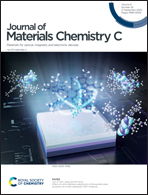Thienoquinolinone as a new building block for wide bandgap semiconducting polymer donors for organic solar cells†
Abstract
A new heterocyclic aromatic structure, thieno[3,2-c]quinolin-4(5H)-one (TQO), was designed and synthesized as an electron-accepting building block for donor–acceptor-type copolymers. TQO was copolymerized with 4,8-bis(5-(2-ethylhexyl)thiophen-2-yl)benzo[1,2-b:4,5-b′]dithiophene (BDT) to give PBDT-TQO. Thieno[3,2-c]isoquinolin-5(4H)-one (TIQO), an isomeric structure of TQO, was also synthesized to give PBDT-TIQO. The absorption regions of both polymers cover 300–600 nm, complementary to those of well-known non-fullerene acceptors (ITIC or IT-4F). PBDT-TQO exhibited a slightly wider bandgap and a lower highest occupied molecular orbital energy level than PBDT-TIQO, owing to the different intra-molecular charge transfer characteristics. Photovoltaic devices fabricated using PBDT-TQO and PBDT-TIQO donors with a fullerene acceptor (PC71BM) showed the maximum power conversion efficiency (PCE) of 3.02 and 3.92%, respectively, while those using the non-fullerene acceptors (ITIC or IT-4F) showed much higher PCEs. The device using PBDT-TQO:IT-4F showed the highest PCE of 7.62%, with a short-circuit current of 14.44 mA cm−2, an open circuit voltage of 0.90 V, and a fill factor of 58.92%.



 Please wait while we load your content...
Please wait while we load your content...